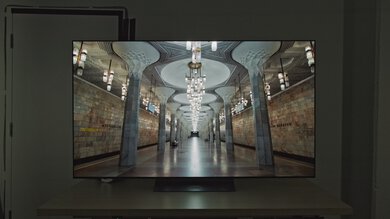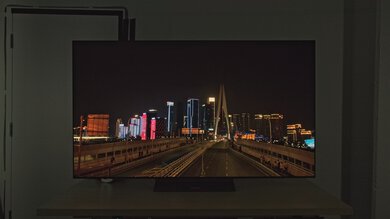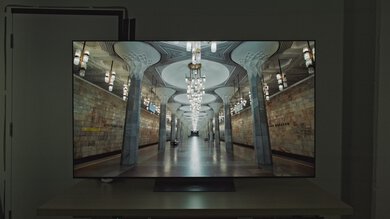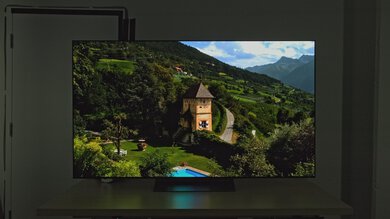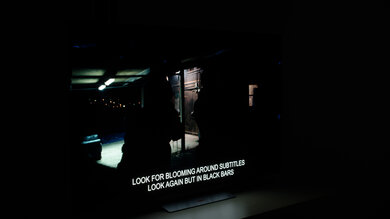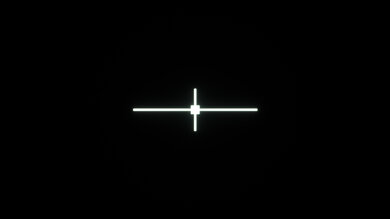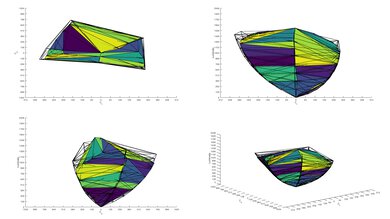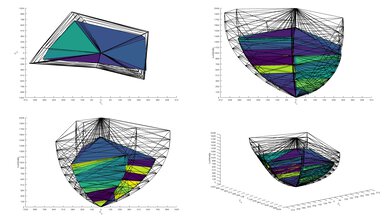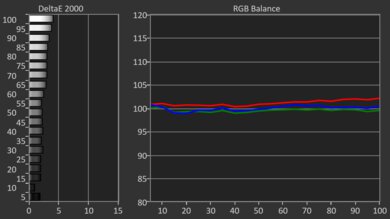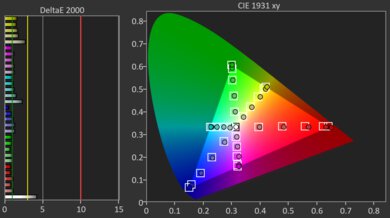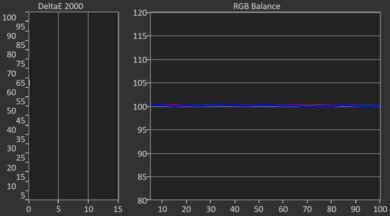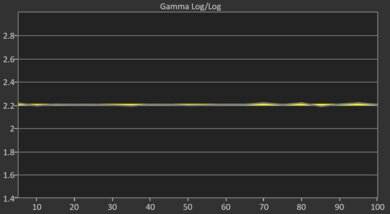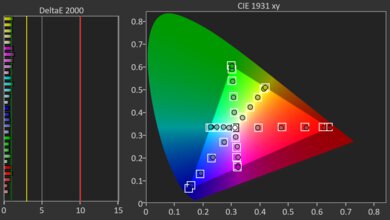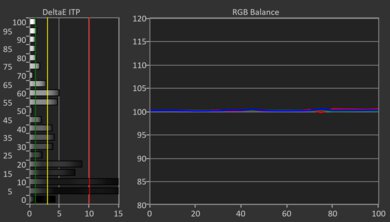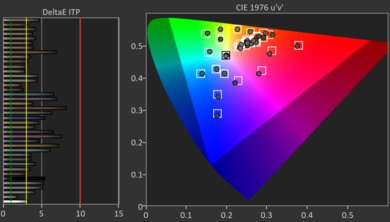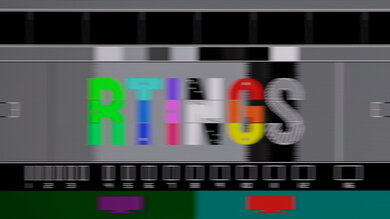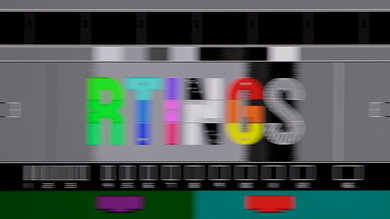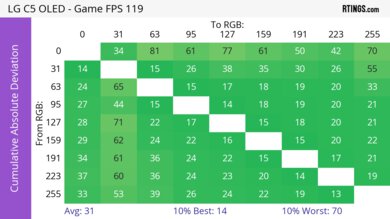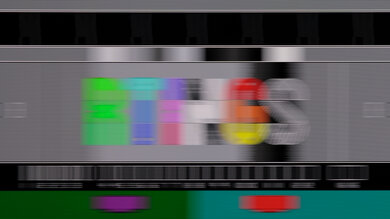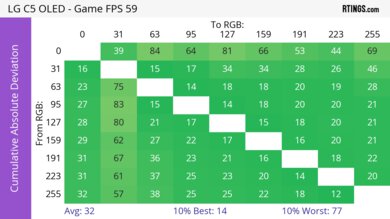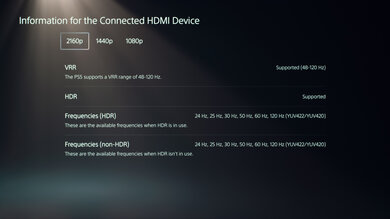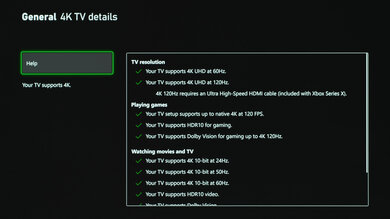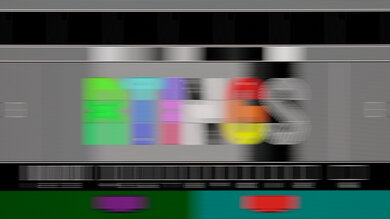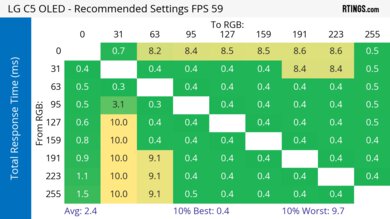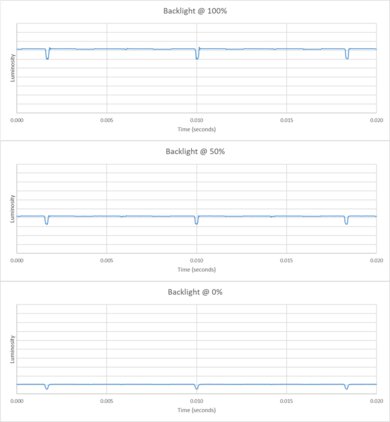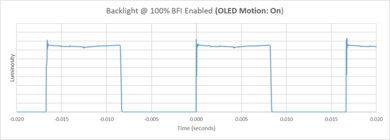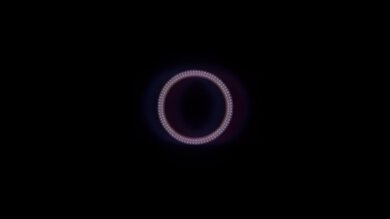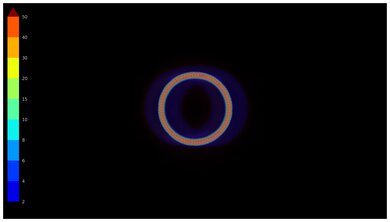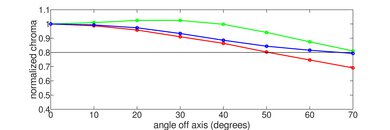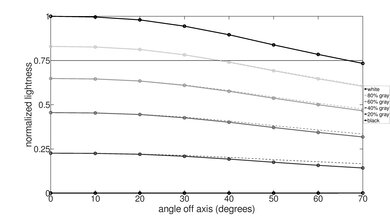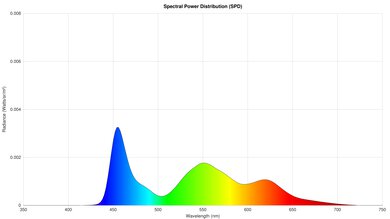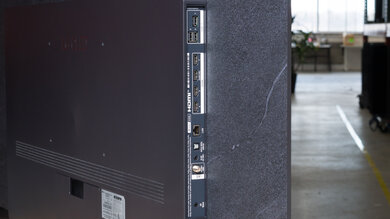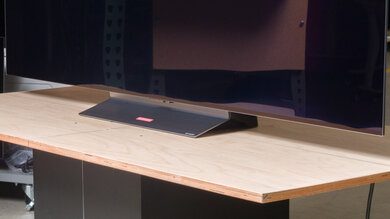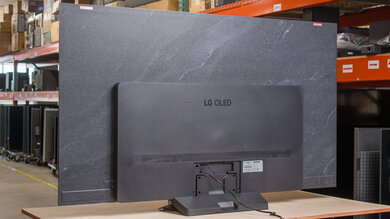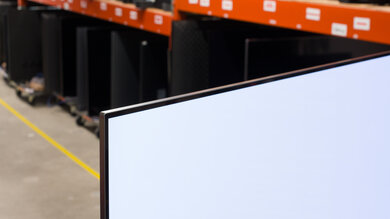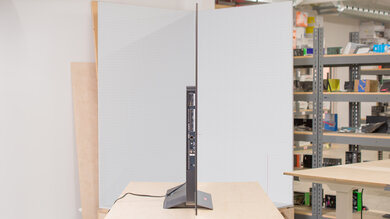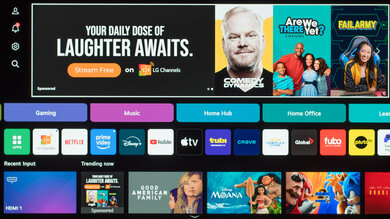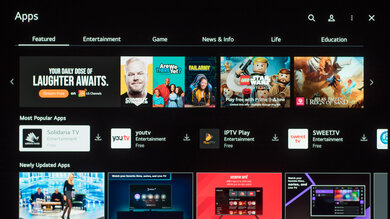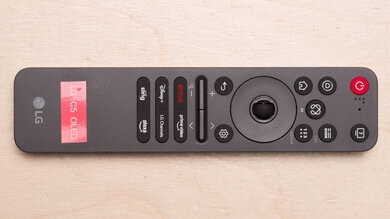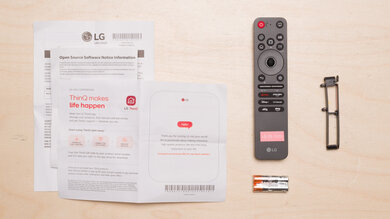LG has been releasing their C Series OLEDs since 2016, and they've become some of, if not the most popular, OLEDs on the market. The LG C5 is the 2025 iteration in their OLED lineup and replaces the 2024 LG C4 OLED. It sits between the lower-end LG B5 OLED and the flagship LG G5 OLED. Unlike the G5, the C5 still uses a traditional WOLED panel and uses the slightly less advanced Alpha 9 AI Processor Gen8. However, it still comes packed with a suite of advanced features, like HDMI 2.1 bandwidth on all four ports for up to 4k @ 144Hz gaming with VRR. It also supports the popular Dolby Vision HDR format, but LG has dropped support for DTS audio passthrough throughout their entire 2025 TV lineup after supporting it on most of their 2023 and 2024 models. The TV runs the 2025 version of LG's webOS and comes with a new version of LG's Magic Remote. We bought and tested the 65-inch model, but it's also available in 42, 48, 55, 77, and 83-inch sizes.
Our Verdict
The LG C5 is excellent for mixed usage. It looks its best in a dark room thanks to its perfect black levels and vivid colors, but you barely lose any image quality when you turn your lights on, which is great. It also has the brightness needed to overcome glare from indirect light sources, but it does struggle more with reducing the intensity of light sources that are directly facing the screen. The TV is loaded with a ton of modern gaming features, making it fully compatible with modern consoles and a terrific addition to your PC gaming setup. Finally, its wide viewing angle makes it a solid choice for watching the game with a large group of friends. Overall, this is a versatile TV.
-
Near-infinite contrast ratio for perfect blacks with no blooming around bright highlights.
-
Very wide viewing angle for a consistent image from the sides.
-
Very good SDR brightness makes it suitable for well-lit rooms.
-
Colors are vibrant, lifelike, bright, and accurate.
-
HDR10 has unusual contouring in dark scenes that makes the image look ugly.
-
Direct light sources are noticeable on the screen.
The LG C5 is an excellent choice for a home theater. The TV has perfect black levels due to its OLED panel, so it looks incredible in a dark room. Highlights in HDR really pop against those perfect blacks, due to the TV's great HDR brightness. Colors are rich and vibrant in both SDR and HDR, so the viewer gets a vibrant viewing experience with all content. Due to its nearly instantaneous response time, there's stutter in 24fps movies and shows that are most noticeable during slow camera movements, but this is expected on any OLED. Unfortunately, the TV has an issue that affects dark scenes in HDR10 content, so it's best to stick with Dolby Vision when possible.
-
Near-infinite contrast ratio for perfect blacks with no blooming around bright highlights.
-
Colors are vibrant, lifelike, bright, and accurate.
-
Great HDR brightness makes highlights pop out.
-
Has excellent upscaling and low-quality content smoothing.
-
Great HDR brightness accuracy.
-
Noticeable stutter due to the TV's fast response time.
-
HDR10 has unusual contouring in dark scenes that makes the image look ugly.
-
Doesn't passthrough DTS audio formats.
The LG C5 is good for a bright room. It has the SDR brightness needed to overcome glare from indirect reflections in most bright rooms. However, its direct reflection handling is only alright, so you do see the reflection of any light source you have placed opposite the screen, especially during darker scenes. Fortunately, blacks stay very deep and colors retain their vibrancy in a room with ambient lighting, so you don't have to trade in picture quality when you have your lights turned on.
-
Very good SDR brightness makes it suitable for well-lit rooms.
-
Colors are vibrant, lifelike, bright, and accurate.
-
Blacks remain deep and colors stay vibrant in a room with ambient lighting.
-
Direct light sources are noticeable on the screen.
The LG C5 is very good for watching sports. The TV is bright enough to overcome glare from indirect lighting. Although it does an alright job of reducing the intensity of direct reflections, you still see the reflection of lamps or windows that are opposite the screen. The TV displays colors that are vibrant and accurate, so your favorite team's jersey looks the same as the one you're wearing when you watch the game. It has excellent upscaling and smoothing capabilities, which help low-resolution and low-quality feeds look good. Finally, image quality mostly stays consistent no matter where you’re sitting due to its wide viewing angle, making it an excellent choice for watching the big game with a group.
-
Very wide viewing angle for a consistent image from the sides.
-
Very good SDR brightness makes it suitable for well-lit rooms.
-
Colors are vibrant, lifelike, bright, and accurate.
-
Has excellent upscaling and low-quality content smoothing.
-
Direct light sources are noticeable on the screen.
The LG C5 is an excellent TV for gaming. It has a suite of modern gaming features like HDMI 2.1 bandwidth on all four ports, VRR, and up to 4k @ 144Hz, so it has great compatibility with consoles and gaming PCs. Fast motion is sharp due to its almost instantaneous response time, and its low input lag delivers a responsive feel, especially at higher refresh rates. The TV displays inky blacks and punchy colors, so you get very impressive image quality regardless of the game. Although its HDR brightness is good enough for an impactful experience while using the Game Optimizer, it's noticeably dimmer than the other picture modes.
-
Low input lag at 120Hz and 144Hz for a very responsive experience.
-
Nearly instantaneous response time for no noticeable blur behind fast motion.
-
Colors are vibrant, lifelike, bright, and accurate.
-
Great HDR brightness makes highlights pop out.
-
HDR10 has unusual contouring in dark scenes that makes the image look ugly.
-
Not as bright in HDR as the other picture modes when using the Game Optimizer picture mode.
The LG C5 has surprisingly great brightness overall and receives a very noticeable uptick in brightness compared to the LG C4 OLED. Its SDR brightness is very good, so it overcomes glare in most bright rooms. Its HDR brightness is great, making small and medium-sized highlights pop out in HDR content.
-
Very good SDR brightness makes it suitable for well-lit rooms.
-
Great HDR brightness makes highlights pop out.
Since the LG C5 is an OLED, it displays remarkably deep and inky blacks with no blooming around highlights.
-
Near-infinite contrast ratio for perfect blacks with no blooming around bright highlights.
The LG C5 has great colors overall. Its color volume is very good in SDR and HDR, so you get vibrant and punchy colors regardless of the format your content is in. This is also a very accurate TV out-of-the-box that mostly stays true to the content creator's intent when it comes to colors, so although some color purists will want to calibrate the TV, it's not necessary for most people who care about the filmmaker's intent.
-
Colors are vibrant, lifelike, bright, and accurate.
Note: We're in the process of improving our tests related to image processing, but this score should give you a general idea of how a TV performs overall with its image processing capabilities.
The LG C5 has great image processing overall. It does an excellent job removing artifacts from low-quality feeds and upscaling low-resolution content, leaving you with a sharp and clean enough image to enjoy. Its PQ EOTF tracking isn't perfect, but it's still great, so HDR content is mostly displayed at the brightness level the filmmaker intends. The TV's gradient handling is good, but there's apparent banding in grays and dark greens, which mostly affects darker scenes.
-
Has excellent upscaling and low-quality content smoothing.
-
Great HDR brightness accuracy.
The LG C5 has fantastic responsiveness while using the Game Optimizer. It has HDMI 2.1 bandwidth on all four ports, supports 4k @ 144Hz, and is compatible with all three flavors of VRR, so it pairs excellently with consoles and gaming PCs. Fast motion is sharp and clear across its entire refresh rate range, especially at higher refresh rates, due to its nearly instantaneous pixel transitions. It also delivers a responsive gaming experience thanks to its low input lag, most notably at 120Hz and 144Hz.
-
Low input lag at 120Hz and 144Hz for a very responsive experience.
-
Nearly instantaneous response time for no noticeable blur behind fast motion.
We're in the process of fixing the way we evaluate a TV's overall motion handling. This section is currently broken, and the score isn't indicative of how well a TV handles motion overall.
- 8.5 Mixed Usage
- 8.7 Home Theater
- 7.7 Bright Room
- 8.1 Sports
- 8.8 Gaming
Performance Usages
- 8.3 Brightness
- 10 Black Level
- 8.1 Color
- 8.4 Processing (In Development)
- 9.3 Game Mode Responsiveness
- 7.6 Motion Handling (Broken)
Changelog
-
Updated Jun 02, 2025:
We mentioned the newly reviewed Samsung S90F OLED in the HDR Brightness in Game Mode section of this review.
- Updated May 13, 2025: Review published.
- Updated May 08, 2025: Early access published.
- Updated Apr 24, 2025: Our testers have started testing this product.
- Updated Apr 23, 2025: The product has arrived in our lab, and our testers will start evaluating it soon.
Differences Between Sizes And Variants
We bought and tested the 65-inch LG C5 (OLED65C5); these results are also valid for the 55, 77, and 83-inch sizes. The 42-inch and 48-inch sizes don't have LG's Brightness Booster technology, so they don't get as bright as the bigger models do. Note that the last three letters in the model number (PUA in this case) vary between retailers and individual regions, but there's no difference in performance. The variant sold at Sam's Club carries the suffix 'AUA' and comes with an extended warranty.
| Size | US Model | Warehouse Variant | Brightness Booster |
|---|---|---|---|
| 42" | OLED42C5PUA | - | No |
| 48" | OLED48C5PUA | OLED48C5AUA | No |
| 55" | OLED55C5PUA | OLED55C5AUA | Yes |
| 65" | OLED65C5PUA | OLED65C5AUA | Yes |
| 77" | OLED77C5PUA | OLED77C5AUA | Yes |
| 83" | OLED83C5PUA | OLED83C5AUA | Yes |
Our unit was manufactured in March 2025, as seen on the label.
Compared To Other TVs
The LG C5 OLED is an excellent TV that does well in most usages. It has a noticeable uptick in brightness over the 2024 LG C4 OLED, so it's more suitable for well-lit rooms, does a better job displaying bright highlights in HDR content, and has better HDR color volume. It's great for gamers due to its modern features and outstanding performance, and being an OLED, it's a top-notch choice for a home theater. It doesn't have the same color capabilities as a QD-OLED like the Samsung S90F OLED, but it does a superior job maintaining its picture quality in a bright room and supports the popular Dolby Vision HDR format. If those things are important to you, but you can't justify the price of the LG G5 OLED, it's a solid choice that is sure to impress. Unfortunately, like the LG G5 OLED, dark scenes in HDR10 are plagued by a strange contouring issue, so you might want to wait and see if LG releases a firmware update to fix the problem.
For more options, check out our recommendations for the best OLED TVs, the best gaming TVs, and the best TVs for watching movies.
The LG C4 OLED and the LG C5 OLED are very similar overall, but the C5 is noticeably brighter. Due to this extra brightness, the C5 fights more glare in a well-lit room, displays brighter highlights in HDR content, and has better color volume. However, there's one caveat with the C5: dark scenes have strange contouring in HDR10, making some scenes look a bit ugly. One advantage the C4 has is that it supports DTS audio passthrough, making it more compatible if you don't have a receiver or soundbar with HDMI inputs.
The LG G5 OLED is better than the LG C5 OLED. The G5 is brighter in SDR and has superior reflection handling, making it more suitable for very bright rooms. The G5 has better HDR brightness and color volume, delivering a more impactful HDR experience, although the C5 is no slouch with that. The G5 also has a slightly better upscaling and supports 165Hz, making it a bit more versatile.
The LG G4 OLED and the LG C5 OLED are surprisingly close. The C5 gets brighter in SDR, helping it fight a bit more glare from indirect reflections, and its black levels stay deeper in a bright room. Inversely, the G4 does a better job of handling direct reflections and has better HDR brightness. The G4 also maintains its brightness while using the Game Optimizer picture mode, delivering a slightly more impactful HDR experience. Finally, the G4 has less banding in color gradients, supports DTS audio passthrough, and doesn't suffer from the strange HDR10 contouring issue that the C5 does.
The LG C5 OLED is better than the LG C3 OLED. The C5 gets noticeably brighter overall, meaning it overcomes more glare in a bright room and delivers a more impactful HDR experience. The C5 also supports 144Hz and has better upscaling, but the C4 supports DTS audio passthrough.
The LG C5 OLED is a big improvement over the LG C2 OLED, as it's noticeably brighter in HDR and SDR and has 144Hz support at 4k; the C2 tops out at 120Hz. The C5 also has better image processing, especially when it comes to upscaling low-resolution content, although the C2 has better HDR brightness accuracy. Overall, while the C5 is a clear upgrade, it currently suffers from an HDR10 contouring issue, making most HDR content look rather ugly on the panel; wait for a firmware upgrade before making the jump.
The LG C5 OLED and the Samsung S90F OLED trade blows. They're about equally as bright in most HDR content, although the S90F is far brighter in Game Mode. In SDR, however, the C5 is way brighter. The S90F does handle direct reflections better, but the C5's black levels barely raise in bright environments, while the S90F's blacks become charcoal gray in the same context. The S90F's QD-OLED panel is far more colorful than the C5's WOLED panel, which is expected. They're about equally as good for gaming, although the C5's Dolby Vision support does give it the slight edge for Xbox gamers. Unfortunately, the C5's HDR10 issues make the S90F the clear choice for now.
The LG C5 OLED is better than the Sony BRAVIA 8 OLED. The LG is brighter in SDR, making it better suited for a bright room. The LG is also brighter in HDR and it's the more accurate TV, so it provides a more impactful HDR experience that stays closer to the filmmaker's intent. Finally, the LG is more versatile for gamers due to its four HDMI 2.1 ports and support for 144Hz.
The LG C5 OLED and the Samsung S90D OLED trade blows. The LG is brighter in SDR and does a better overall job handling reflections, making it look better in a bright room. The LG also has better image processing, so it's more versatile with different levels of content. On the other hand, the Samsung has the advantage when it comes to colors thanks to its QD-OLED panel.
The LG C5 OLED is better than the Samsung S85F OLED in most ways. The LG is a lot brighter overall, so it overcomes more glare in bright rooms and displays more impactful highlights in HDR content. The LG does a better job of removing artifacts from low-bitrate content and upscaling low-resolution content, so it's a better TV when the quality of your content is less than ideal. The LG also supports Dolby Vision, making it more versatile overall. However, the Samsung has the advantage with color vibrancy due to its QD-OLED panel.
The LG C5 OLED is better than the Hisense U8QG overall. The Hisense is the better choice for a bright room due to its superior brightness capabilities and punchier colors. The Hisense supports 4k @ 165Hz and 1080p @ 288Hz, and it also has a USB-C alt-display port, but VRR and 288Hz don't work when using the port.
However, most gamers will prefer the LG, since it has clearer motion and lower input lag overall. The LG also displays perfect blacks, is more accurate, has better image processing, and a much wider viewing angle, making it the better option for home theaters.
Video
Test Results
The LG C5 has great HDR brightness and has a nice uptick in brightness compared to the 2024 LG C4 OLED. Small and medium-sized highlights really stand out in dim and moderately lit scenes, so this TV displays most highlights in real HDR content mastered at 600 and 1000 nits. HDR scenes that are entirely bright are noticeably dimmer, so you do notice a decrease in brightness when bright elements are taking up the majority of the screen, but not so much that they lack impact.
Our results above are with the TV set to Filmmaker Mode with 'Dynamic Tone Mapping' disabled. Below are the results with DTM turned on, which increases the brightness of some highlights at the expense of accuracy.
- Hallway Lights: 1054 cd/m²
- Yellow Skyscraper: 868 cd/m²
- Landscape Pool: 477 cd/m²
Results with 'Expression Enhancer' set to 'Brightness'.
- Hallway Lights: 1112 cd/m²
- Yellow Skyscraper: 708 cd/m²
- Landscape Pool: 328 cd/m²
Results with 'Dynamic Tone Mapping' enabled and 'Expression Enhancer' set to 'Brightness'.
- Hallway Lights: 1038 cd/m²
- Yellow Skyscraper: 822 cd/m²
- Landscape Pool: 474 cd/m²
Unfortunately, the LG C5 is noticeably dimmer when using Game Optimizer. You still get an impactful HDR gaming experience, with highlights that stand out well, but you do notice the dip in brightness when switching from another picture mode. If this bothers you, the Samsung S90F OLED doesn't lose any of its brightness in Game Mode.
Our results above are with 'Dynamic Tone Mapping' disabled. Below are the results with DTM turned on, which increases the brightness of some highlights at the cost of accuracy.
- Hallway Lights: 1182 cd/m²
- Yellow Skyscraper: 689 cd/m²
- Landscape Pool: 315 cd/m²
Results with 'Expression Enhancer' set to 'Brightness'.
- Hallway Lights: 1110 cd/m²
- Yellow Skyscraper: 517 cd/m²
- Landscape Pool: 210 cd/m²
Results with 'Dynamic Tone Mapping' enabled and 'Expression Enhancer' set to 'Brightness'.
- Hallway Lights: 946 cd/m²
- Yellow Skyscraper: 748 cd/m²
- Landscape Pool: 311 cd/m²
The LG C5 OLED has very good SDR brightness, especially for a WOLED model, and receives a pretty significant increase in SDR brightness compared to the 2024 LG C4 OLED. Bright elements that take up small and medium portions of the screen have great brightness, but there's a noticeable decrease in luminance during entirely bright scenes. Still, this TV overcomes glare in a well-lit room with most content.
The LG C5 is an OLED without a backlight, so its self-lit pixels give it the same performance as a TV with perfect local dimming and no zone transitions. We still film the zone transition video so you can see how it compares to an option with local dimming.
The TV has good SDR color volume. Like almost any TV, it has full coverage of the most commonly used Rec.709 color space. It also covers the majority of the DCI-P3 color space, only struggling a bit with some lighter shades. Its coverage of the widest BT.2020 color space is lacking, and here, it struggles to cover most shades.
Still, this TV is a good choice to watch the odd SDR content that's mastered in these wider color spaces, and it's also a solid choice if you like to force Rec.709/sRGB content into a wider color space for increased saturation.
| Volume ΔE³ | DCI-P3 Coverage | BT.2020 Coverage |
|---|---|---|
| L10 | 97.72% | 66.38% |
| L20 | 98.13% | 66.63% |
| L30 | 98.20% | 67.81% |
| L40 | 97.59% | 69.51% |
| L50 | 96.90% | 70.17% |
| L60 | 94.56% | 67.75% |
| L70 | 90.07% | 58.04% |
| L80 | 90.20% | 55.62% |
| L90 | 88.93% | 54.64% |
| L100 | 77.38% | 50.39% |
| Total | 93.07% | 62.51% |
The TV has very good HDR color volume. Due to its perfect contrast, it displays dark, saturated colors very well. It does an amazing job displaying bright whites, and most other bright colors are displayed well. However, it does struggle a bit more with bright reds, magentas, and yellows. These results are in Filmmaker Mode, but you can see the TV's HDR color volume in Game Optimizer below. Fortunately, there's barely a loss of color brightness when using the gaming mode.
- 1,000 cd/m² DCI P3 Coverage ITP: 88.2%
- 10,000 cd/m² BT.2020 Coverage ITP: 39.6%
- White Luminance: 1381 cd/m²
- Red Luminance: 132 cd/m²
- Green Luminance: 444 cd/m²
- Blue Luminance: 45 cd/m²
- Cyan Luminance: 487 cd/m²
- Magenta Luminance: 173 cd/m²
- Yellow Luminance: 576 cd/m²
The TV has great SDR accuracy before calibration. Its white balance is very good, but there's too much red in most shades of gray, which contributes to the TV's slightly too warm color temperature. Gamma is very close to 2.2, but most scenes are a bit too dark. The accuracy of colors is excellent, with only minor inaccuracies in whites and very light shades of cyan and yellow. This is a TV that mostly stays true to the content creator's intent out-of-the-box.
If you're after the most accurate SDR image possible, the TV is easy to calibrate and has outstanding accuracy after the fact. Any minor issues with white balance, gamma, color temperature, and color accuracy are gone, leaving you with an image that's about as accurate as you can get.
The TV supports AutoCal through Calman using a 1D and 3D LUT, which is great if you want to simplify the calibration process.
See our full calibration settings.
The LG C5 has excellent HDR accuracy before calibration. Its white balance is outstanding, with only some darker grays being noticeably inaccurate. Still, its color temperature is very close to the industry standard 6,500K. Colors have very good accuracy overall, but there's some mapping errors throughout, with reds and magentas being undersaturated. Despite these inaccuracies, this TV respects the filmmaker's intent without needing calibration.
Calibrating the TV is easy, but it doesn't do very much to further improve accuracy. Its white balance is a bit better now, but dark grays are still inaccurate. Color temperature is a bit better, but the difference is barely noticeable. Color accuracy has improved the most, and most colors look very accurate, but reds and magentas are still a bit undersaturated.
The LG C5 has great PQ EOTF tracking. Some near blacks are a bit brighter than intended, and some midtones are a bit dimmer than intended, but the TV follows the curve closely. There's a roll-off with content mastered at 600 and 1000 nits to help maintain detail in highlights, but the TV is bright enough to display most highlights without needing to tone map. With content mastered at 4000 nits, the roll-off is a lot more gradual, since the TV needs to rely on tone mapping to display very bright highlights without a major loss of detail.
The TV's game mode, as well as additional settings like dynamic tone mapping and the expression enhancer, change the way it follows the PQ EOTF curve.
The LG C5 has good HDR native gradient handling. There's some visible banding in grays and dark greens, but all other gradients have minimal banding or no banding at all.
The TV's input lag when using Game Optimizer is very low across the board. As your refresh rate increases, input lag lowers, which is great for gamers chasing the best performance possible. At 120Hz and 144Hz, it's especially low, giving you a very responsive gaming experience.
The TV's input lag is a lot higher outside of its gaming mode, so you do feel a bit of lag when doing things like pausing movies and scrolling through menus.
Below are some additional input lag measurements.
4:3 @ 60Hz:
- 640x480: 27.0 ms
- 800x400: 34.4 ms
- 1024x768: 26.6 ms
HDR Filmmaker Mode with Game Optimizer Enabled and the Input Label Set to 'PC':
- 60Hz: 23.1 ms
- 120Hz: 13.4 ms
- 144Hz: 11.3 ms
SDR Filmmaker Mode with Game Optimizer Enabled and the Input Label Set to 'HDMI':
- 60Hz: 47.9 ms
- 120Hz: 39.2 ms
- 144Hz: 32.9 ms
The TV supports all common resolutions up to 4k @ 144Hz, and it supports chroma 4:4:4, so it has great compatibility with gaming consoles and PCs.
The TV supports FreeSync and HDMI Forum VRR and is certified as G-SYNC compatible, ensuring a nearly tear-free gaming experience from any VRR-enabled source. It works well across the TV's entire refresh rate range and supports sources with Low-Frame-Compensation (LFC), which ensures your games remain nearly tear-free even when your frame rate drops very low.
The TV's CAD at 60Hz is fantastic. Most transitions from one RGB level to another are nearly instantaneous, but there's some minor overshoot when pixels transition from black to brighter shades. There's also still some noticeable persistence blur.
The LG C5 is fully compatible with everything the PS5 offers, like 1440p @ 120Hz and 4k @ 120Hz, as well as HDMI Forum VRR. It also supports Auto Low Latency Mode, so you don't have to worry about switching to Game Optimizer to get the lowest input lag.
The LG C5 is fully compatible with everything the Xbox Series X|S offers, including 1440p @ 120Hz, 4k @ 120Hz, HDMI Forum VRR, FreeSync Premium Pro, and Dolby Vision gaming. It also supports Auto Low Latency Mode, so you don't have to worry about switching to Game Optimizer to get the lowest input lag.
Unfortunately, due to the nearly instantaneous pixel response time of the TV, there's stutter with low frame rate content, which is most noticeable during slow panning shots.
The TV removes judder when watching 24p movies or TV shows when the Real Cinema setting is enabled, even from sources that can only send a 60Hz signal, like a cable box. Unfortunately, Real Cinema is locked when OLED Motion Pro (BFI) is enabled, so movies and TV shows aren't judder-free when BFI is enabled, since the BFI feature only flickers at 60Hz.
The LG C5 has a nearly instantaneous response time, resulting in incredibly clear motion with almost no blur behind fast-moving objects when watching content. Due to the sample-and-hold nature of OLED technology, there's still some persistence blur at 60Hz, but it's not very noticeable when watching movies or shows.
The LG C5 doesn't have a traditional backlight and doesn't use pulse-width modulation (PWM) to dim each pixel, but it's not completely flicker-free. There's a slight dip in brightness that corresponds to the TV's refresh rate. This is very different from the PWM flicker on TVs with LED backlights and occurs on every OLED we've tested. It's not noticeable, and most people won't be bothered by this, but it can still bother people who are extra sensitive to flicker.
The LG C5 has an optional black frame insertion (BFI) feature known as 'OLED Motion Pro' that reduces the appearance of persistence blur at 60Hz. Unfortunately, it can only insert black frames at a 60Hz refresh rate, and there's still some blur present.
The LG C5 has an optional motion interpolation feature to help improve the appearance of motion. It works well with slower scenes, but there's noticeable haloing and artifacts present in faster scenes, especially if you use the settings too aggressively. Setting 'De-Judder' to '1' is a decent option if you want to mitigate some stutter, and it doesn't introduce obvious amounts of the soap opera effect with that setting.
The LG C5 has decent color vibrancy in a bright room. Colors barely lose any vibrancy, and they remain well-saturated in a room with ambient lighting.
Like all OLED TVs, the LG C5 has a very wide viewing angle. This makes it a great choice for a wide seating arrangement, as the image doesn't lose brightness and blacks remain deep when viewed at an angle.
There's a noticeable green tint on the C5 we bought and tested. It's a widespread issue that impacts almost all LG OLED panels but varies widely from unit to unit.
The TV uses a WOLED panel with a RWBG pixel structure where all four pixels are never lit at the same time. Due to its subpixel layout, it has minor issues with displaying text on Windows since ClearType isn't well optimized to non-RGB subpixel layouts, but most users won't be bothered by this.
The white subpixel does an excellent job helping the TV display bright whites, but it dilutes the color purity of greens and reds.
Unfortunately, there are diagonal lines that appear as a result of dithering. These lines are quite apparent when watching content or playing games if you're sitting close to the screen, but the lines aren't nearly as visible from a normal viewing distance.
The LG C5 supports the full 48Gbps bandwidth of HDMI 2.1 on all four HDMI ports. This allows you to take full advantage of multiple high-bandwidth devices, such as if you own both current-gen consoles and a high-end gaming PC.
The LG C5 OLED TV passes through all Dolby Digital options. However, it doesn't support any DTS audio formats commonly used on physical media. LG has supported DTS on all of their 2023 and 2024 OLED models, but they've dropped support across their entire lineup in 2025.
The LG OLED C5 supports HDR10 and Dolby Vision. Unfortunately, there are glaring issues with HDR10 content during near black scenes and in scenes with dark gradients. It's not as prevalent as it is on the LG G5 OLED, but dark elements in some dimly lit scenes are contoured in a very strange manner. Dolby Vision is unaffected by this issue, and by comparing the shot from The Green Knight below, you can see how apparent this strange contouring can be in HDR10.
- The Green Knight: Dolby Vision
- The Green Knight: HDR10
The LG OLED65C5PUA has a very sleek and modern design. It's very similar to 2024's LG C4 OLED, except the unique stone-like finish on the back is a darker shade of gray. The TV's bezels are incredibly thin, so you barely see them while using it.
The included stand holds the TV well. It only lifts the TV about 2.8 inches, but this is high enough that most soundbars fit underneath without blocking the screen. Note that the width of the stand depends on the model size, and the 42-inch model comes with two feet instead of a center-mounted stand.
Footprint of the 65-inch stand: 18.55" x 9.1".
The back of the TV is pretty much identical to the LG C4 OLED, but the stone-like finish is now a much darker shade of gray. The inputs are on the far left side of the TV, which makes them easy to access if you have the TV on the stand. However, they're hard to reach when the TV is wall-mounted. There are channels on the back of the TV and on the stand to help with cable management.
The LG C5 OLED TV runs the 2025 version of LG's proprietary smart interface, webOS. The interface supports user profiles, so you can customize the home page for different users. LG promises at least four years of webOS updates on their TVs, and you get updated versions of the operating system once a year.
Sometimes, the TV doesn't properly switch out of the Game Optimizer setting, so you're locked out of settings that should be available in other picture modes. To fix this, you can turn Game Optimizer on and disable ALLM and VRR. When you do this and switch to a different picture mode, everything works as it should. To avoid this, it's best to use a dedicated input for gaming and a separate input for your other devices.
There are two settings in the 'Home Settings' menu, namely the 'Home Promotion' and 'Content Recommendation' settings. These settings remove the top banner ads and suggested content from the home screen. This gives your home screen a clean look, but there's no way to remove ads from the apps page.
The TV comes with LG's new Magic Remote. Like the old version, it can be used as a pointer, or you can use the traditional buttons to control the TV. Unfortunately, LG ditched the number pad on this new remote, so you can't assign quick launch shortcuts anymore. There's also no dedicated input button, so you have to use the home dashboard to switch inputs.
The TV consumes a maximum of 331W of power, which is a lot more than the 215W maximum that the 2024 LG C4 OLED consumes.
The TV has a decent frequency response. Bass isn't super deep, but it's not non-existent, so you feel a bit of rumble. The sound profile is well-balanced at most volume levels, but as you reach maximum volume, dialogue becomes a bit difficult to understand. Unfortunately, the TV's speakers don't get very loud.


